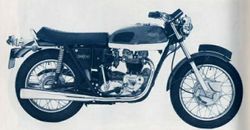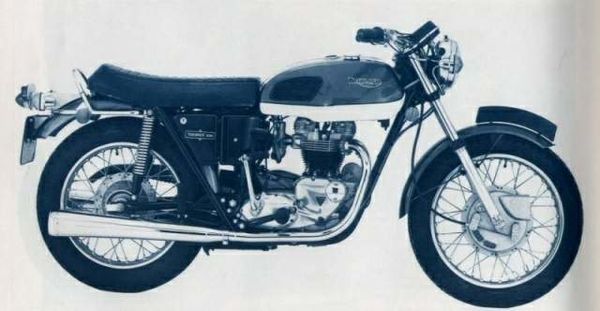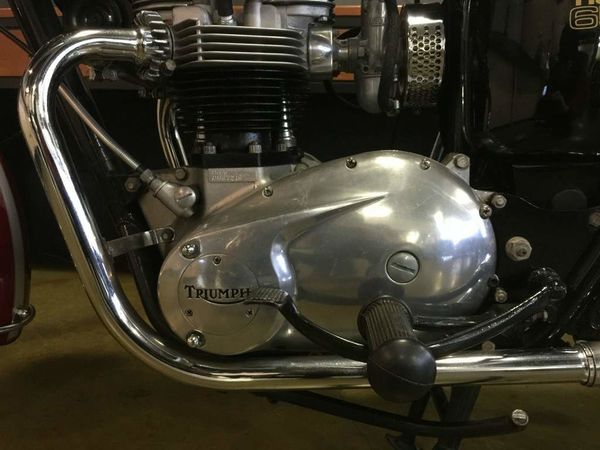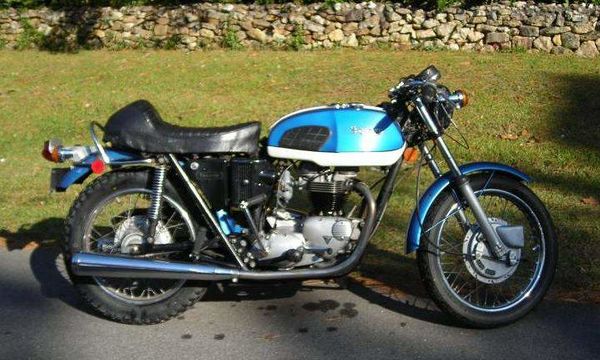Triumph TR 6R650 Tiger
 |
|
| Triumph TR 6R650 Tiger | |
| Manufacturer | |
|---|---|
| Production | 1973 |
| Engine | Four stroke, parallel twin cylinder, OHV |
| Compression ratio | 9.0:1 |
| Ignition | 12V Battery and coil, Lucas |
| Transmission | 4-Speed |
| Frame | Welded frame with large diameter oil-containing main tube |
| Suspension | Front: Telescopic fork, 2-way hydraulic damping Rear: Swingarm, dual shocks, hydraulically damped, adjustable preload |
| Brakes | Front: Drum, 2LS, 200 mm / 8" Rear: Drum, 1LS, 180 mm / 7" |
| Front Tire | 3.25 x 19 K70 |
| Rear Tire | 4.00 x 18 K70 |
| Wheelbase | 1420 mm / 56 in |
| Seat Height | 790 mm / 31 in |
| Weight | 175 kg / 385 lbs (dry), |
| Fuel Capacity | 18.2 L / 4.8 US gal / 4.0 Imp gal |
| Manuals | Service Manual |
Engine[edit | edit source]
The engine featured a 9.0:1 compression ratio.
Drive[edit | edit source]
Power was moderated via the Wet, multiplate.
Chassis[edit | edit source]
It came with a 3.25 x 19 K70 front tire and a 4.00 x 18 K70 rear tire. Stopping was achieved via Drum, 2LS, 200 mm / 8" in the front and a Drum, 1LS, 180 mm / 7" in the rear. The front suspension was a Telescopic fork, 2-way hydraulic damping while the rear was equipped with a Swingarm, dual shocks, hydraulically damped, adjustable preload. The TR 6R650 Tiger was fitted with a 18.2 L / 4.8 US gal / 4.0 Imp gal fuel tank. The bike weighed just 175 kg / 385 lbs. The wheelbase was 1420 mm / 56 in long.
Photos[edit | edit source]
Overview[edit | edit source]
Triumph Tiger 650 TR6R
'You'll be tops when you
take to the road with a Tiger!' said Triumph's marketing men back in
1971, keeping an admirably straight face. Triumph resurrected the Tiger
title for this roadster-style single-carb 650 twin which, like its
twin-carb Bonneville brother, slotted in to the firm's new oil-in-frame
chassis.
Carbs apart, the Tiger was almost identical to the
Bonneville and claimed to have 'performance to spare, with tractability,
economy and smooth running. Beautifully finished in striking colors, it
is designed for hard work and relaxed riding. The best of both worlds
it's the bike which shows Triumph power can be as flexible as a foil.
The secret is the big twin OHV engine delivering 47bhp with its single
carb, providing maximum flexibility with greater torque at lower rpm.'
Indeed, they weren't telling too many big fat fibs. The Tiger proved to be only slightly slower at the top end than the Bonneville and its single Amal carb needed less fettling, but it still boasted gutsy grunt at low revs and better fuel economy. The Tiger delivered its maximum output at 6500rpm while the Bonneville revved 500rpm higher to provide maybe three or four more horsepower. The TR6R cost £488 new in 1971 while the T120R cost £525. Both bikes featured the engine specification which had stood Triumph in good stead for several decades; aircooled twin cylinders of 71mm bore by 82mm stroke to give a capacity of 649cc; pushrod operated overhead valves with gear-driven cams; light alloy head, plain big end bearings and ball/roller main bearings; running at 9:1 compression (or 8.5:1 in the USA). In 1971 the Tiger used a four-speed gearbox; the five-speed version was introduced the following year. The Tiger featured down-swept exhausts with balance pipe; its stablemate the TR6C kept the Trophy nametag with its competition associations and had high-rise exhaust pipes stacked on one side. All the 650 twins of this era came with 12 volt, twin coil electrics and indicators which would only work when the moon was waxing, the wind was blowing north by northwest, and the correct incantation had been intoned by the infuriated rider. Usually something involving 'four', 'forks' and 'ache'. The oil-bearing frame with duplex downtubes was all-new and largely unwelcome at the time, and gave the press something to complain about for ages. The hinged seat was initially 34 inches tall (later reduced to 32 inches) and, it has to be said, quite wide, which came as a shock to many riders who were used to British twins being lithe and low. If you jump onto a TR6R from a Laverda Jota or a Suzi GS850 then it'll feel fairly petite, but if you're used to a rigid single from the 1930s then you might want to wear your longer legs that day The Tiger's bounce came courtesy of swinging arm rear suspension with dual Girling shocks, hydraulically damped and adjustable for load. At the front end the two-way hydraulic damping was provided by a new set of slimline forks with polished ally sliders. When first launched the Tiger didn't wear gaiters although they were reintroduced a year later, and you'll notice that this bike sensibly sports a set. The chrome of this period was not prone to staying attached to the motorcycle for many British winters and the stanchions wore rapidly, while the exposed fork legs allowed dirt to shred the seals. The Dunlop K70 tires were fitted to a 19-inch front and 18-inch rear wheel, with a conventional seven inch drum brake at the rear and a rather more controversial set-up at the sharp end. The eight inch, twin-leading-shoe, light alloy conical hub brake needs longer brake arms to be really effective, and even then can be tricky to adjust. Having said that, I've met a couple of conical hub stoppers which have been good enough to lift the rear wheel when applied with alacrity, so the one seen here is probably more than capable of coping with the extra mass of the sidecar. Normally, a solo TR6R would weigh around 385lb. Some 7500 of these bikes were built in 1971, and then another 3500 in 1972. That was the final year of production for the TR6R which was replaced by the 744cc twin.
Source:
| Make Model | Triumph Tiger 650 TR6R |
|---|---|
| Year | 1973 |
| Engine Type | Four stroke, parallel twin cylinder, OHV |
| Displacement | 649 cc / 39.6 cu in |
| Bore X Stroke | 76 x 71.5 mm |
| Compression | 9.0:1 |
| Induction | 30 mm Amal concentric carburetor, R930 |
| Ignition | 12V Battery and coil, Lucas |
| Starting | Kick |
| Max Power | 31.3 kW / 42 hp @ 6500 rpm |
| Max Torque | 50.1 Nm / 5.1 kgf-m / 37 ft-lb @ 5500 rpm |
| Clutch | Wet, multiplate |
| Transmission | 4-Speed |
| Final Drive | Chain |
| Gear Ratios | 1st 12.08 / 2nd 8.36 / 3rd 6.15 / 4th 4.66:1 |
| Frame | Welded frame with large diameter oil-containing main tube |
| Front Suspension | Telescopic fork, 2-way hydraulic damping |
| Rear Suspension | Swingarm, dual shocks, hydraulically damped, adjustable preload |
| Front Brakes | Drum, 2LS, 200 mm / 8" |
| Rear Brakes | Drum, 1LS, 180 mm / 7" |
| Front Tire | 3.25 x 19 K70 |
| Rear Tire | 4.00 x 18 K70 |
| Dimensions | Length: 2220 mm / 87.5 in Width: 736 mm / 29.0 in |
| Wheelbase | 1420 mm / 56 in |
| Ground Clearance | 178 mm / 7 in |
| Seat Height | 790 mm / 31 in |
| Dry Weight | 175 kg / 385 lbs |
| Fuel Capacity | 18.2 L / 4.8 US gal / 4.0 Imp gal |


